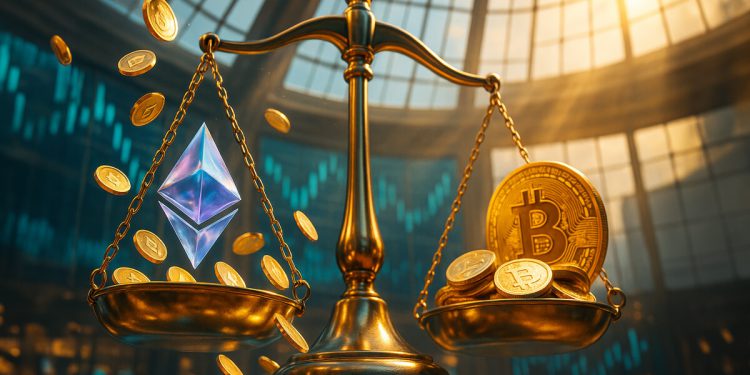US-traded spot Ethereum exchange-traded funds (ETFs) recorded persistent outflows during late September and mid-October, periods that coincided with relative weakness in the ETH/BTC ratio.
Yet, non-US inflows and continued staking growth blunted the price impact, suggesting the headwind is episodic rather than structural.
The question of whether ETF redemptions drive Ether’s underperformance against Bitcoin requires parsing flow data alongside derivatives positioning, staking supply sinks, and regional divergences.
ETF creations and redemptions reflect authorized-participant activity rather than direct buying or selling, and their relationship to price is conditional on broader market structure, such as funding rates, basis spreads, and competing yield opportunities.
The evidence shows outflow windows correspond to ETH/BTC softness when derivatives positioning turns negative, but staking inflows and European buying have repeatedly absorbed US selling pressure, limiting the transmission from flows to spot.
Flow patterns and timing
US spot Ether ETFs swung between heavy inflows in July and August and multi-week outflow periods in late September and mid-to-late October.
The week ending Sept. 26 saw record US redemptions of approximately $796 million, concentrated in Grayscale’s ETHE as investors rotated to lower-fee products or exited positions entirely.
Outflows resumed around Oct. 23-24, with the week ending Oct. 27 recording roughly $169 million in net redemptions across US Ether ETPs.
Those periods aligned with ETH/BTC declines on a weekly close-to-close basis, supporting the hypothesis that flows carry a price signal.

The opposite pattern appeared in early October. The week ending Oct. 6 brought approximately $1.48 billion in net inflows to the US.
Ether ETFs during a broader risk-on environment, and ETH/BTC stabilized or ticked higher. That correlation between inflows and relative strength, and outflows and relative weakness, holds across the July-to-October window when aggregated to weekly frequency.
However, the relationship is noisy at daily intervals and breaks down when regional or derivatives factors dominate.
Non-US Ether exchange-traded products complicate the narrative. CoinShares data show Germany, Switzerland, and Canada absorbed Ether ETPs during mid-October US outflows, resulting in net global inflows in some weeks despite US redemptions.
Hong Kong’s spot Ether ETFs remain smaller but add a second ex-U.S. data point as that market matures.
The regional divergence implies US flows are necessary for price modeling but not sufficient, global demand can offset domestic selling, particularly when European investors view drawdowns as entry points.
Derivatives amplify flow signals
The relationship between ETF flows and ETH/BTC performance strengthens when derivatives positioning agrees.
CME Ether futures open interest and perpetual funding rates act as amplifiers. When the three-month annualized basis slips into negative territory and funding rates turn negative, outflow-driven price pressure intensifies.
Conversely, positive basis and elevated funding can mute the impact of redemptions by signaling speculative demand and willingness to pay for leverage.
Data from CME Group show Ether futures open interest climbing through October, reflecting heightened institutional participation around the flow cycles.
Weighted average perpetual funding rates tracked by aggregators turned negative during the late-September outflow window and again in mid-October, suggesting leveraged long positions unwound alongside ETF redemptions.
That dual pressure, spot selling via ETF redemptions and derivatives deleveraging, appears to drive the periods of sharpest ETH/BTC underperformance.
When the basis and funding stabilize or turn positive, the flow-price link weakens. Early October’s inflow surge corresponded with a shift to positive funding and firmer basis, and ETH/BTC stopped declining despite mixed signals elsewhere in crypto markets.
The interaction term between flow direction and derivatives positioning is more predictive than flows alone, matching prior research on Bitcoin ETFs, which found that flows explain roughly 32% of daily price variance when isolated but gain explanatory power when combined with leverage metrics.
Staking and liquid staking tokens as supply sinks
Ethereum’s Beacon Chain validator count continued rising through October, with net validator entries absorbing ETH supply that might otherwise flow to exchanges or ETF redemption baskets.
Liquid staking token protocols, including Lido’s stETH, Coinbase’s cbETH, and Rocket Pool’s rETH, also recorded supply growth during the outflow windows, indicating organic staking demand persisted independent of ETF activity.
Quantifying the offset requires comparing weekly changes in staked ETH and LST outstanding against weekly ETF net flows.
Beacon Chain data show validator additions equivalent to tens of thousands of ETH per week during September and October, while LST supply growth tracked similar magnitudes.
When combined, staking sinks often matched or exceeded US ETF outflows every week, suggesting that redemptions removed ETH from exchange-traded wrappers without flooding spot markets, as staking absorbed the released supply.
Tokenized US Treasuries offering four to 5% yields on-chain represent a competing destination for capital that might otherwise allocate to ETH or Ether ETFs.
Real-world asset protocols reported tokenized Treasury supply ranging from $5.5 billion to $8.6 billion through 2025, providing a risk-free rate alternative that can siphon inflows during periods when Ether’s total return lags short-term rates.
The competition is most acute among institutional allocators, who compare Ether ETFs with tokenized money-market instruments, particularly when ETH volatility rises or the ETH/BTC ratio stagnates.
Measuring the flow-price relationship requires weekly aggregation to smooth intraday noise and alignment with ETH/BTC weekly closes to capture relative performance.
Correlations between net weekly ETF flows and weekly ETH/BTC returns are positive during the July-to-October window. Still, the coefficient varies depending on whether derivative positioning and regional flows are included as controls.
Adding interaction terms for basis state and funding direction improves fit, confirming that flows matter most when derivatives agree.
ETF creations and redemptions reflect authorized-participant activity in response to premium/discount dynamics and end-investor orders, not direct market-making.
Daily flow prints can be revised, and issuer-level differences in fees and tax-lot structure create noise in aggregate series.
The analysis also assumes that flows translate into spot buying or selling, which holds when authorized participants hedge creation/redemption baskets in spot markets but breaks down when hedging occurs via derivatives or over-the-counter desks.
The lag between reported flows and actual market impact can span hours to days, complicating intraday correlation tests and supporting weekly frequency as the appropriate unit of analysis.
What to monitor next
ETF flows will continue signaling marginal demand shifts, but their predictive value depends on confirming signals from derivatives and regional data.
Weekly monitoring should track US net flows, non-US ETP direction, on a three-month basis, weighted perpetual funding, and validator queue depth.
When US outflows coincide with negative basis, negative funding, and flat staking growth, the headwind intensifies. When European or Canadian inflows offset US redemptions, or when staking absorbs released supply, the price impact fades.
Catalysts that could flip the flow regime include Ethereum protocol upgrades that affect staking economics, changes in US ETF fee structures that reduce ETHE’s cost disadvantage, or macro shifts that compress Treasury yields and reduce RWA competition.
The relationship between flows and ETH/BTC also depends on Bitcoin’s own ETF dynamics. If Bitcoin ETFs see heavy inflows while Ether ETFs face redemptions, the relative underperformance compounds.
Tracking both asset classes in parallel provides the cleanest read on whether Ether-specific factors or broader crypto sentiment drives the ratio.
US spot Ether ETF outflows have corresponded with ETH/BTC weakness when derivatives positioning and regional flows align, but staking growth and non-U.S. buying have repeatedly absorbed redemptions and limited spot price transmission.
The headwind is real during concentrated outflow windows with negative basis and funding, but it is episodic rather than structural.
Flows matter most as a risk indicator that confirms or contradicts signals from derivatives, staking, and cross-border demand, not as a standalone driver of Ether’s relative performance.
























